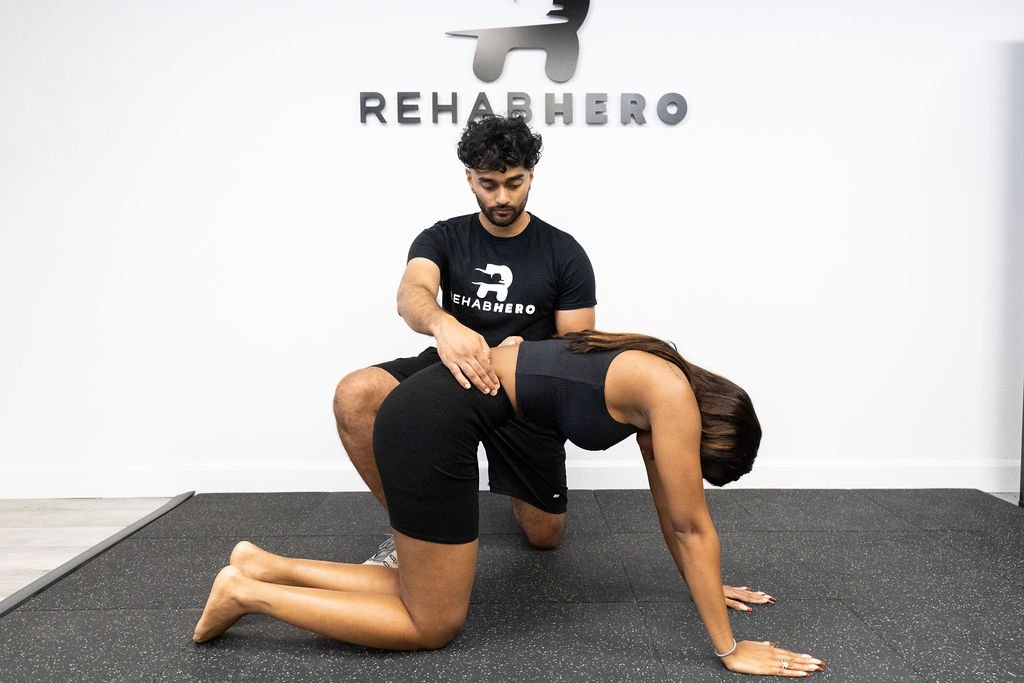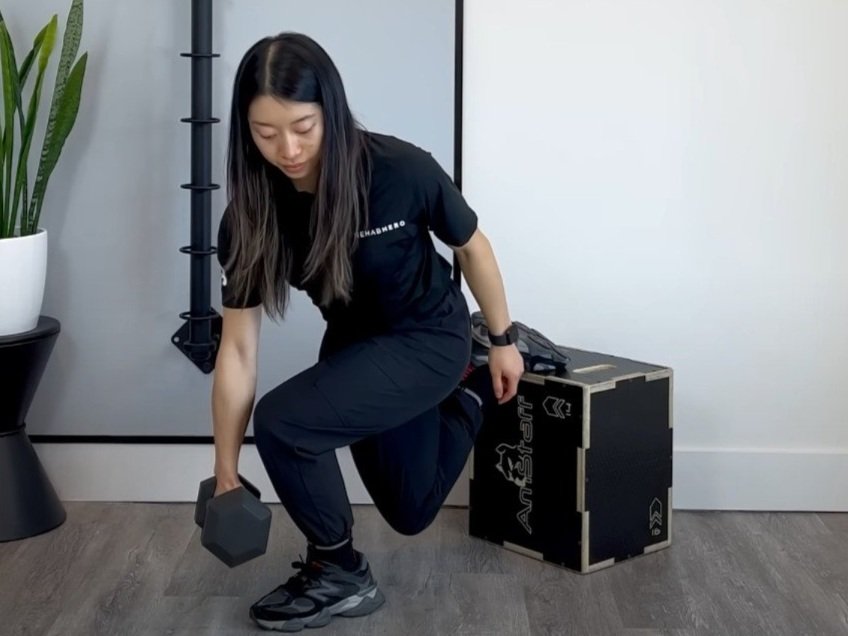Open vs Closed Kinetic Chain
What is the difference between open and closed chain?
Learn more about open and closed chain exercises, the advantages of each, and if you should incorporate them into your workouts!
What is a kinetic chain? That’s a term we constantly hear from therapists, fitness trainers, and high-level athletes. To learn what an open or closed chain is, we first need to understand what a kinetic chain is. A kinetic chain, also known as a kinematic chain, is used to describe human movement. This engineering concept first suggested that rigid, overlapping segments in the body were connected by joints and collectively created a system. In other words, there are interrelated muscles, bones and joints in the body that are connected in a chain, they work together to perform movements. The system works through movement at one joint to affect the movement at another joint in a kinetic link. The concept was further adapted and suggested extremities, such as the hands and feet, are rigid, overlapping segments connected by a series of joints. Movement of one segment affects segments close and far from the first joint segment. The kinetic chain can also describe what part of the spine the movement is connected to. The kinetic chain can be described as upper or lower. Based on this overall concept, movements and exercises can be classified as open kinetic chain (OKC) or closed kinetic chain (CKC). Each of the kinetic chains have their own advantages.
Upper Kinetic Chain:
The upper kinetic chain can include the following body regions:
Hands
Fingers
Wrists
Forearms
Elbows
Shoulders
Shoulder blades
Spinal column
Lower Kinetic Chains:
The lower kinetic chain can include the following body regions:
Spine
Pelvis
Hips
Legs
Knees
Ankles
Feet
Toes
Open Kinetic Chain (OKC):
In an open kinetic chain (OKC), the segment furthest away, known as the distal segment, from the body is free and not fixed to an object. The distal segment is typically the hand or the foot. OKC exercises allow one to isolate specific muscle groups, improve strength and increase range of motion. OKC exercises are often incorporated into early rehab programs to improve the strength and range of motion of isolated muscles.
Examples of Open Chain Upper Body Kinetic Exercises:
Examples of Open Chain Lower Body Kinetic Exercises:
Closed Kinetic Chain (CKC):
Closed kinetic chain (CKC) exercises are movements where the furthest segment, or distal aspect of a limb, is fixed to an object that is stationary, such as the ground or a solid surface. The benefits of CKC exercises are that they require work from multiple joints and muscle groups in the body at once, overall improving balance, stability, and strength. Many people also incorporate CKC exercises into their rehab programs because they offer functional stimulation. These types of movements often require muscle activation that is both coordinated and sequential to create ideal joint movement.
Examples of Closed Chain Upper Body Kinetic Exercises:
Examples of Closed Chain Lower Body Kinetic Exercises:
What’s the research behind open vs closed chain exercises?
Improves lower body balance: A study in 2021 by Yi et al., investigated the effects of OKC exercises for the calf and shin muscles on stationary and active balance and strength. The study found that in their group of 21 healthy participants, OKC exercises with resistance bands performed twice a week for 4 weeks were effective for increasing muscle strength in the calf and shin.
Increases thigh muscle thickness: A study in 2020 by Cheon et al., aimed to compare muscular changes in the muscles of the upper thigh after OKC and CKC exercises. They strived to identify the effects of these exercises on the upper thigh for early rehabilitation to prevent knee joint injury. In the group of 26 healthy participants, the thickness of their upper thigh muscles was measured. The study found that in some participants, the thickness of specific upper thigh muscles improved after OKC exercises and increased significantly after CKC exercises.
Strengthens upper body muscles: A study in 2018 by Kim and Jang, investigated the effects of OKC and CKC exercises on the muscle activity of the chest and triceps. Twenty healthy male college studies were analyzed a total of three times over the course of two weeks. The study measured the amount of power and force applied by the two muscles during the exercises. The study found that both OKC and CKC exercises may be effective for strengthening muscular activity in the chest and triceps muscles.
Improves balance abilities and vertical jump height: A study in 2021 by Gim and Choi, investigated the effects of OKC and CKC core stability exercises on stationary and active balance abilities and vertical jump height in participants with chronic ankle instability. Eighteen participants were divided randomly into groups and their balance and vertical jump heights were measured before and after the study. The participants would perform their exercises for 30 minutes two times a week for a total of 6 consecutive weeks. The study found that both OK and CKC core stability exercises improved stationary and active balance abilities and vertical jump height in patients with chronic ankle instability. The study also found that the OKC exercises were more effective in enhancing stationary balance abilities compared to CKC exercises.
Should you add these exercises to my workouts?
The type of exercises included in your workout should be based on a variety of factors. These factors may include your specific condition, activity level, stage of rehab, goals, and more. All of these will be considered by a therapist or trainer to help develop your exercise program. For some, focusing on OKC exercises are beneficial for isolated muscle strength and can improve muscular aesthetics for specific goals. Whereas, CKC exercises have become popular due to its functionality. OKC and CKC exercises provide a great framework and can help improve your balance, strength, and function. At the end of the day in most situations, exercise can benefit people of all ages and fitness levels, and a combination of both OKC and CKC exercises in a rehab program can provide optimal benefits. Make sure to consult an exercise specialist, such as a therapist or fitness trainer, to decide if these types of exercises should be included in your training plan.
Conclusion
In OKC exercises, the body segment furthest away is not fixed, compared to CKC exercises, the body segment furthest away is fixed to a stationary object or surface. OKC exercises isolate muscle groups, improve strength and range of motion. CKC exercises are functional and increase balance. Exercises have many health and performance benefits and adding OKC and CKC exercises to your workout may be a way to step-up your muscular and functional gains. If you think OKC and CKC exercises would be beneficial in your exercise program, get assessed by a professional. To book in with a Rehab Hero therapist to receive tips on how to add open and closed chain exercises to your workouts, click the button below:
Written by: Dr. Jessie Luc, DC
Dr. Luc is a chiropractor located at the centre of Sheppard and Yonge. Focused on patient care, she educates her patients on how to address the root cause of their injuries. Outside of the clinic you can find her on the field playing Ultimate Frisbee.
References:
Cheon, Soul, et al. “Acute Effects of Open Kinetic Chain Exercise versus Those of Closed Kinetic Chain Exercise on Quadriceps Muscle Thickness in Healthy Adults.” International Journal of Environmental Research and Public Health, vol. 17, no. 13, 2020, p. 4669., https://doi.org/10.3390/ijerph17134669.
“Closed Chain Exercise.” Physiopedia, https://www.physio- pedia.com/Closed_Chain_Exercise?tm_source=physiopedia&utm_medium=related_articles&utm_campaign=ongoing_internal.
Gim, Mina, and Junghyun Choi. “Comparison of Open and Closed Kinetic Chain Core Exercises for Balance and Vertical Jump Height in Chronic Ankle Instability.” Journal of International Academy of Physical Therapy Research, vol. 12, no. 4, 2021, pp. 2509–2515., https://doi.org/10.20540/jiaptr.2021.12.4.2509.
Kim, Ju-O, and Sang-Hun Jang. “The Effect of Open and Close Kinetic Chain Exercise on the Muscle Activity of Pectoralis Major and Triceps.” The Journal of Korean Academy of Physical Therapy Science, vol. 25, no. 1, 2018, pp. 52–61., https://doi.org/10.26862/jkpts.2018.06.25.1.52.
“Kinetic Chain.” Physiopedia, https://www.physio-pedia.com/Kinetic_Chain.
“Open Chain Exercise.” Physiopedia, https://www.physio-pedia.com/Open_Chain_Exercise#cite_note-p2-9.
Yi, Song Yeon, et al. “Effects of Open Kinetic Chain Exercise for the Gastrocnemius and Tibialis Anterior Muscles on Balance.” The Journal of Korean Physical Therapy, vol. 33, no. 6, 2021, pp. 278–285., https://doi.org/10.18857/jkpt.2021.33.6.278.






















